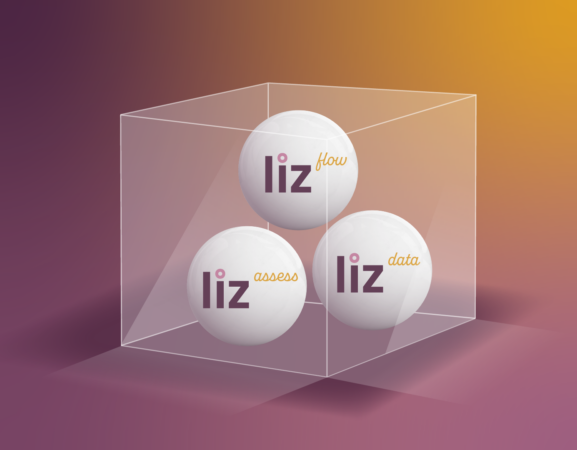Our solutions have been designed to supercharge the customer journey. Since liz is modular, organizations can purchase what they need, when they need it.
Put together, the entire suite is much more than the sum of its parts!
Our solutions have been designed to supercharge the customer journey. Since liz is modular, organizations can purchase what they need, when they need it.
Put together, the entire suite is much more than the sum of its parts!

With the liz suite modules, every action, answer, and modification is fully visible to the business.
With traditional artificial intelligence solutions, all of the computing happens inside a “black box”, meaning the solution is opaque and offers no insight. You have to trust that whatever is happening is robust, accurate, and appropriate.
Our solutions, however, are completely transparent. A glass box that enables clarity, visibility, and control into every flow like never before.
No more guesswork or hoping for the best.
We designed liz as a modular suite to allow clients to buy only the modules they need.
Plus, liz provides the opportunity to create a pre-assessment.
But that’s not all, you also get:

This module provides security where all flow sequences are visible and editable in a Pure no-code environment.
With a drag-and-drop functionality, liz flow delivers the ability to:

Our hyper-personalized underwriting rules engine module, liz assess, provides the mapping infrastructure for every customer journey. It delivers the most secure, fast, and accurate underwriting capabilities in a fraction of the time it normally takes. You also get:

Our data collection and analytics module tops it all off. As data is collected, it provides insights and builds visual representations.
Other benefits include:
Greatest opportunities for underwriters to bonify human processes with augmentation, through algorithms and automation.
We assume augmentation as a partnership between human and AI, or some may refer to it as a human assisted AI.
Human minds are creative and full of imagination, but they periodically require rest.
Machine or AI can virtually perform all routine and boring tasks that make human minds tired, to optimize AI performance. Meanwhile, humans can spend more time and energy on creative tasks.
In the life insurance sector we represent, we already see more effective use of third-party data sources and behavioral models that help reduce the need for additional evidence, and often achieve a high degree of accuracy, even before it gets to human review.
Over time, augmentation should help minimize the number of cases requiring a human touch, and free resources for more critical tasks.
In our vision, the underwriter of the future will do very little underwriting. However, by embracing augmentation, they will transfer most of the workload to AI. Human underwriters will mainly operate, analyze, and adjust machines. Due to the nature of that new exposure, they will also become more valuable to their organization's strategic efforts.
Lag time between change requests from the business and new underwriting systems implementation by IT is a major challenge.
The insurance sector is in the early stages of the no-code revolution, which allows much greater efficiency overall.
For those who are not familiar, no-code technology is one that allows nonprogrammers to create models using graphical interfaces. Think of anyone here, regardless of programming skills, simply being able to move and connect a few boxes on screen to enable a new sequence or flow. No-code makes this possible.
When it comes to underwriting automation and transformation, traditionally, many organizations were chasing speed of underwriting, but the secret really lies in augmented personalization. Essentially, an underwriting model that takes a few minutes longer to complete, but provides a more accurate assessment, and mostly eliminates additional requirements is always better than the one that is just faster.
Currently, life insurance is slowly shifting from static, accelerated underwriting models, to dynamic and more intuitive models, with some even including symbolic AI. However, personalization requires agility and flexibility. It requires frequent adjustments that are virtually impossible to make efficiently given the number of resources and level of complexity tied to a full-code structure.
Now, can you imagine, underwriters creating models for underwriters? Picture minimizing, or at times, even eliminating the need to involve project management, development, and QA resources in that process? Visualize underwriters experimenting with various flows on their own?
In our experience at thinktum, we have created several underwriting models in days! Those same models would typically take several months to create in a full-code structure.
In the end, no-code eliminates the "black box" fear, as it makes for a fully see-through, "glass box" work environment.
Technical details assist organizations in better understanding tech innovations integration and other requirements.
Yes, of course we can. Our solutions have been developed for small to medium-sized companies. Our goal is to help small firms grow.
With thinktum’s Pure no-code platform, you don’t need IT resources or programmers. We have designed our platform to ensure that anyone with even minimal technical skills can operate it. The initial set-up using our convenient API will require some technical assistance – provided by us - but after that, you are free and able to create your own flows on the e-app canvas.
Implementation times depend on a lot of factors; however, full implementation can take us as quick as a few hours to complete, but most organizations require about a three-month timeline to implement all three liz modules. That is including all intermediate steps between meeting us and deciding, then kickstarting the implementation of a module – then rinse and repeat for subsequent ones.
Our platform is Pure no-code, so a simple task such as updating, adding, or removing a question is easily done, then you can test instantly and deploy it right away. It’s all about the intuitive drag-and-drop features.
Our implementation ensures that we walk you through how to operate our modules, and provide learning tools for ongoing support. If a client requires additional training & support, we will be there to provide it. We’ll let you drive with this because you know your people best. We provide just the right amount of handholding. Just let us know.
At thinktum, even if you aren’t tech-savvy, our suite is built for people like you, and is very easy to use. We are there to make sure our clients are all set up and have experts to guide you through the implementation and deployment process.
Our system simply won’t replace your underwriters, it’s been developed to give your underwriters more control. They can design and develop questions to more accurately control and manage the risk, leading to more straight-through business and freeing up their time to tackle the more complex underwriting cases. Underwriters can ensure our system refers all serious health issue cases to them to safeguard your risk appetite thresholds and reflect your underwriting philosophy.
Our liz suite modules work independently as well as together. Organizations can simply buy what they need and add other modules on or not. You do get the most powerful combination when using all three modules together, but even one module can be a game changer.
Pricing always depends on the project; we charge an implementation fee and then a transaction fee (depending on the number of modules subscribed) based on the applications submitted/volume. That way when you do well, so do we. thinktum does not charge an annual subscription or license fee.
The future is pushing toward more and more automation, not less. Our liz suite is remarkably powerful, our customer journey fast and frictionless, and we have expert consultants on staff to assist with whatever is required from the client side. Quick implementation means you can have the liz suite up – or modules from it – and running in a surprisingly short time.
If you have questions about our liz suite, data management, Pure no-code, or how we can help you with your customer journeys, reach out to us. We’re so happy to clarify anything.